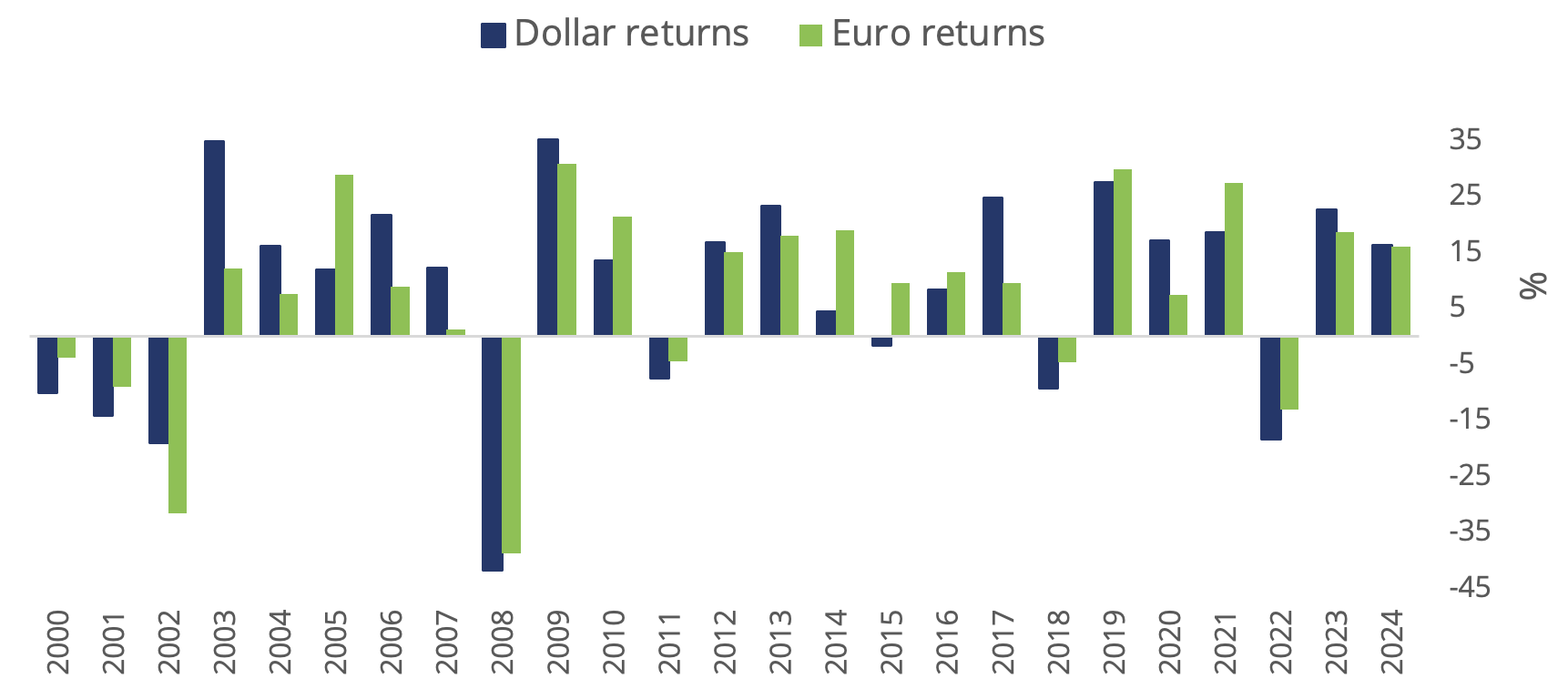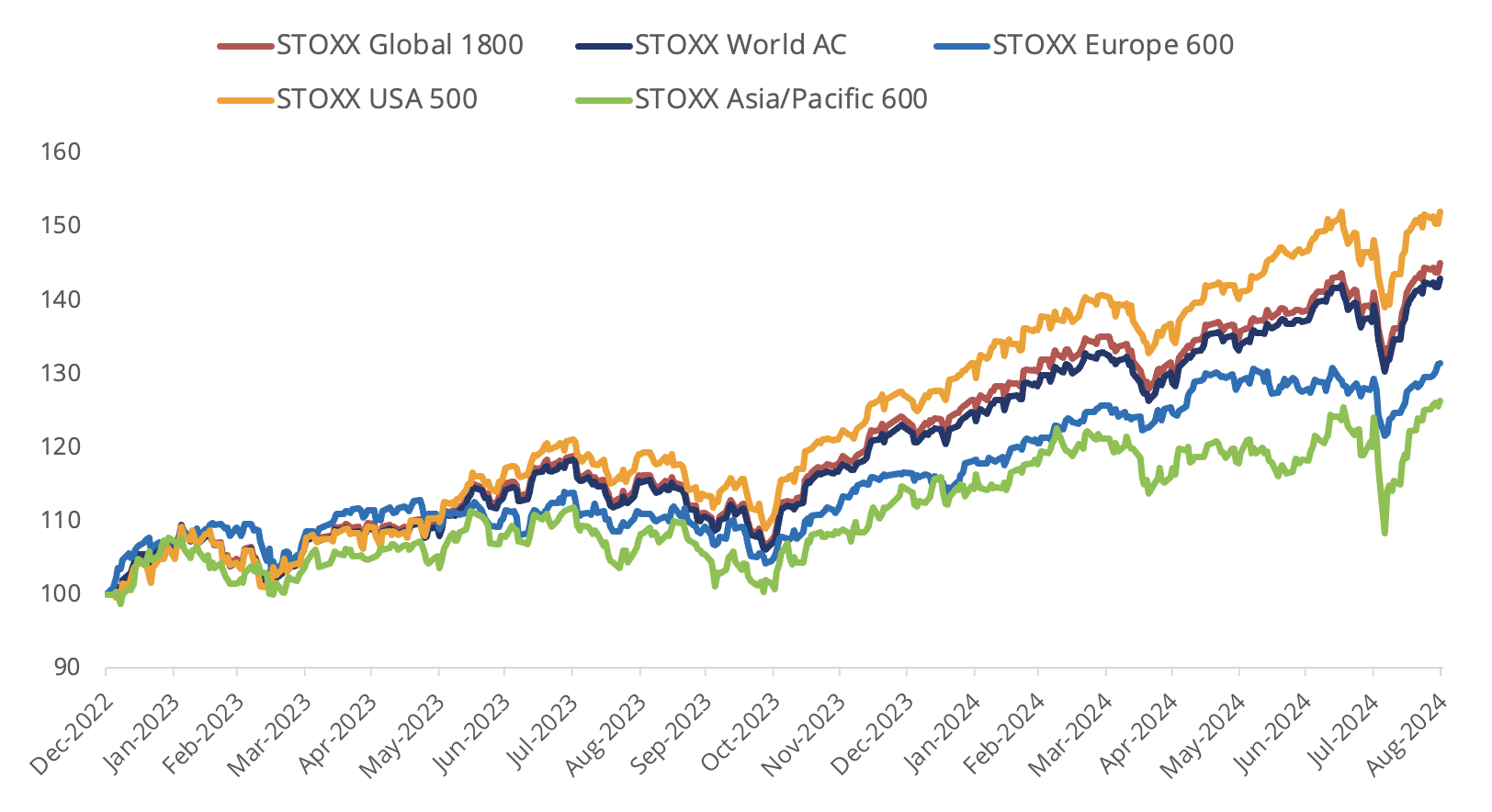Stocks gyrated in August, with benchmarks ending in positive territory for the month, as concern about a US economic slowdown was outweighed by optimism that interest rates will be cut this month.
The STOXX® World AC index rose 2.6% over the month when measured in US dollars and including dividends[1], taking its 2024 gain to 16.4%. The STOXX® Global 1800 index added 2.8% in the month.
The Eurozone’s EURO STOXX 50® rose 1.8% in euros on a total-return basis, while the pan-European STOXX® Europe 600 added 1.6%.[2] The STOXX® North America 600 rose 2.6% in dollars, as did the STOXX® USA 500, its ninth advance in ten months. The STOXX® Asia/Pacific 600 climbed 1.8% in dollars. The STOXX® Developed World rose 2.7% and the STOXX® Emerging Markets gained 1.6%.
Figure 1: STOXX Equity World indices’ August risk and return

Figure 2: STOXX Benchmark indices’ August risk and return

Germany’s DAX® increased 2.2% in the month. MDAX®, which gauges the performance of German mid-caps, climbed 1.3%.
Figure 3: DAX indices’ August risk and return

| For a complete review of all indices’ performance last month, visit our August index newsletter. |
Inflation reports
Benchmarks started the month on a negative note, with the STOXX World AC index dropping 6.5% in the first three sessions amid concerns of an economic slowdown in the US and an increase in Japanese interest rates.
However, falling US inflation figures released last month changed the narrative in markets by lifting investors’ expectations that the Federal Reserve will cut rates this month. Minutes of Fed policymakers’ July meeting, released August 22, showed a majority of them were ready to cut borrowing costs in the September gathering.
Figure 4: Total annual % returns for STOXX World AC index

Figure 5: Select STOXX benchmarks’ returns since 2023

Volatility jumps, then drops
The EURO STOXX 50® Volatility (VSTOXX®), which tracks EURO STOXX 50 options prices, slipped to 15.3 at the end of last month from as high as 31.2 on August 5 and from 15.7 at the end of July. A higher VSTOXX reading suggests investors are paying up for puts that offer insurance against stock price drops. The VDAX-New®, which measures volatility in German equities, ended the month at 14.3, from 14.4 in July.
Factor investing
Among the STOXX Factor indices, the Low Risk signal led gains last month (Figure 6).
Figure 6: STOXX Factor (Global) indices’ August risk and return characteristics

Climate benchmarks
Within climate benchmarks, the STOXX® Global 1800 Paris-Aligned Benchmark (PAB) rose 3.3%, as did the STOXX® Global 1800 Climate Transition Benchmark (CTB). The PAB and CTB indices follow the requirements outlined by the European Commission’s climate benchmarks regulation.
Sustainability indices
The STOXX® Global 1800 ESG-X index advanced 2.8% in the month. The STOXX® ESG-X indices are versions of traditional, market-capitalization-weighted benchmarks that observe standard responsible exclusions.
Within indices that combine exclusions and best-in-class ESG integration, the EURO STOXX 50® ESG index gained 1.6% over the month. Germany’s DAX® 50 ESG index (+2.4%)[3], which excludes companies involved in controversial activities and integrates ESG scoring into stock selection, beat the benchmark DAX in the month.
The STOXX® Global 1800 SRI rose 2.6%. The STOXX SRI indices apply a set of carbon emission intensity, compliance and involvement screens, and track the best ESG performers in each industry group within a selection of STOXX benchmarks.
Finally, the DAX® ESG Screened added 2.5% in the month. The index reflects the composition of the DAX benchmark minus companies that fail to pass norms-based and controversial weapons screenings, meet minimum ESG ratings or are involved in certain business activities considered undesirable from a responsible investing perspective.
Thematics, digital assets
Only 13 of 36 STOXX® Thematic indices outperformed the benchmark STOXX Global 1800 last month. The STOXX® Global Silver Mining index (-6%) showed the biggest loss, while the STOXX® Global Health & Weight Loss (+8.1%) index led gains.
The STOXX® Digital Asset Blue Chip index, which aims to track high-quality assets that represent the crypto universe today, fell 18.4% in the month.
Dividend strategies
Dividend strategies performed strongly in the month that ended. The STOXX® Global Maximum Dividend 40 (+3.2% on a net basis) selects only the highest-yielding stocks. The STOXX® Global Select Dividend 100 (+2.7%) tracks companies with sizeable dividends but also applies a quality filter such as a history of stable payments.
Minimum variance
Minimum variance strategies also had a strong month relative to benchmarks. The STOXX® Global 1800 Minimum Variance and the STOXX® Global 1800 Minimum Variance Unconstrained both climbed 5.2%.
The STOXX Minimum Variance Indices come in two versions. A constrained version has similar exposure to its market capitalization-weighted benchmark but with lower risk. The unconstrained version, on the other hand, has more freedom to fulfill its minimum variance mandate within the same universe of stocks.
[1] All results are total returns before taxes unless specified.
[2] Throughout the article, all European indices are quoted in euros, while global, North America, US, Japan and Asia/Pacific indices are in US dollars.
[3] Figures in parentheses show last month’s gross returns.
